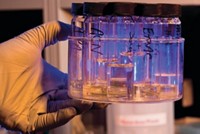Advertisement
Grab your lab coat. Let's get started
Welcome!
Welcome!
Create an account below to get 6 C&EN articles per month, receive newsletters and more - all free.
It seems this is your first time logging in online. Please enter the following information to continue.
As an ACS member you automatically get access to this site. All we need is few more details to create your reading experience.
Not you? Sign in with a different account.
Not you? Sign in with a different account.
ERROR 1
ERROR 1
ERROR 2
ERROR 2
ERROR 2
ERROR 2
ERROR 2
Password and Confirm password must match.
If you have an ACS member number, please enter it here so we can link this account to your membership. (optional)
ERROR 2
ACS values your privacy. By submitting your information, you are gaining access to C&EN and subscribing to our weekly newsletter. We use the information you provide to make your reading experience better, and we will never sell your data to third party members.
Business
Pfizer Outlines R&D Structure
After merger with Wyeth, drug giant will have two research teams
by Ann M. Thayer
April 13, 2009
| A version of this story appeared in
Volume 87, Issue 15
BECAUSE PFIZER wants to hit the ground running when it completes its acquisition of Wyeth this year, it has already announced the structure that its substantial R&D operation will take. Building on the complementary strengths of the companies, Pfizer will form two research organizations supporting the combined company’s nine business areas.
Instead of having a single R&D unit spending its more-than-$10 billion annual research budget, the company will divide efforts into two distinct groups led by presidents reporting directly to CEO Jeffrey B. Kindler.
Pfizer’s current global R&D head, Martin Mackay, will lead PharmaTherapeutics Research Group, which is focused on small molecules. BioTherapeutics Research Group will concentrate on large molecules and vaccines under the direction of Wyeth’s current research president, Mikael Dolsten. It also will incorporate Pfizer’s entrepreneurial Biotherapeutics & Bioinnovation Center, headed by Corey Goodman.
“Creating two distinct, but complementary, research organizations, led by the top scientist from each company, will provide sharper focus, less bureaucracy, and clearer accountability in drug discovery,” Kindler said when announcing the new structure last week.
After its previous acquisitions of Warner-Lambert and Pharmacia, Pfizer was criticized for moving too slowly and stalling innovation; Kindler admitted as much when the Wyeth deal was announced (C&EN, Feb. 2, page 7). Planning ahead this time, Pfizer expects its combined R&D operation will be positioned to start immediately after the merger is completed.
Still, Martha Freitag, a stock analyst at Argus Research, recently warned clients that there will be definite challenges in successfully integrating the two large companies. The combination is expected to accelerate already-planned job cuts and cost-saving moves. In 2008, both companies had begun reorganizing their R&D operations, exiting research in certain disease areas and concentrating more closely on others.
Within the two new R&D groups, Pfizer will create smaller, focused teams targeting specific therapeutic areas and headed by chief scientific officers pulled from both Pfizer and Wyeth. Another team of scientists will seek and evaluate new technologies and early-stage drug candidates from outside Pfizer.






Join the conversation
Contact the reporter
Submit a Letter to the Editor for publication
Engage with us on Twitter